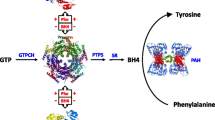Abstract
There is a steady and nonlinear relationship between the levels of both phenylpyruvic acid (PPA) and o-hydroxyphenylacetic acid (oOPAA) in urine and the plasma levels of phenylalanine (phe) in children more than two years of age with phenylketonuria (PKU). If phe levels in blood rise above 0.35 mM (5.8 mg/100 ml) both aromatic acids are found regularly in urine. Typically, urinary concentrations of PPA are about 5 times higher than those of oOPAA. This report is based on the analysis of 94 samples from 51 children, on or off diet.
Similar content being viewed by others
References
Bickel H (1970) Phenylalaninaemia or classical phenylketonuria (PKU)? Neuropädiatrie 1:379–382
Blaskovics ME, Schaeffler GE, Hack S (1974) Phenylalaninaemia, differential diagnosis. Arch Dis Childh 49: 835–843
Blau K (1970) Aromatic acid excretion in phenylketonuria. Analysis of the unconjugated aromatic acids derived from phenylalanine. Clin Chim Acta 27:5–18
Blumenkrantz N, Asboe-Hansen G (1977) Urinary creatinine is unsuitable as reference value for collagen metabolite output. Clin Biochem 10:109–110
Chang PN, Fish RO (1976) Observations of behavioral and personality characteristics of phenylketonurics according to their dietary duration: Early treatment and normal intelligence. Psychol Rep 39:835–841
Dhondt JL, Cartigny B, Farriaux JP (1974) Interêts du dosage de l'acide ortho-hydroxyphénylacétique urinarire dans les hyperphénylalaninémies. Ann Biol Clin 32:499–506
Donker DNJ, Reits D, van Sprang FJ, Storm van Leeuwen W, Wadman SK (1979) Computer analysis of the EEG as an aid in the evaluation of dietetic treatment in phenylketonuria. Electroencephalogr Clin Neurophysiol 46:205–213
Gaull GE, Tallan HH, Lajtha A, Rassin DK (1975) Pathogenesis of brain dysfunction in inborn errors of amino acid metabolism. In: Biology of brain dysfunction, (ed GE Gaull), Vol 3. Plenum, New York and London, pp 47–143
Koepp P, Scholtyssek M, Plettner C (1978) Urinary excretion of aromatic acids in hyperphenylalaninemic states: Response to a protein challenge. Eur J Pediatr 127:269–278
Koff E, Boyle P, Pueschel SM (1977) Perceptual-motor functioning in children with phenylketonuria. Amer J Dis Child 131:1084–1087
Langenbeck U, Mench-Hoinowski A, Dieckmann KP, Möhring HU, Petersen M (1978) O-Trimethylsilylquinoxalinol derivatives of aromatic α-ketoacids; mass spectra and quantitative gas chromatography. J Chromatogr 145:185–193
Langenbeck U, Mench-Hainowski A, Rød-Urban I, Luthe H (1978) Quantitative determination of plasma phenylpyruvic acid by GC-MS with an isomeric internal standard. In: Quantitative mass spectrometry in life sciences (eds AP de Leenheer, R Roncucci, V van Peteghem), Vol 2. Elsevier, Amsterdam, pp 209–219
Partington MW, Vickery SK (1974) Phenylketonemia in phenylketonuria. Neuropädatrie 5:125–137
Rapoport D, Saudubray JM, Hatt A, Weil-Halpern F, Depondt E, Boisse J, Mozziconacci P (1975) Etude psychologique de 20 enfants phénylcétonuriques traités tôt. Ann Pédiat 22:509–516
Rey F, Pellié C, Sivy M, Blandin-Savoja F, Rey J, Frézal J (1974) Influence of age on orthohydroxyphenylacetic acid excretion in phenylketonuria and its genetic variants. Pediat Res 8:540–545
Vink CLJ, Kroes AA (1961) The renal clearance of phenylpyruvate. Clin Chim Acta 6:813–818
Wadman SK, Ketting D, de Bree PK, van der Heiden C, Grimberg MTh, Kruijswijk H (1975) Permanent chemical phenylketonuria and a normal phenylalanine tolerance in two sisters with a normal mental development. Clin Chim Acta 65:197–204
Zelniček E, Podhradská O (1969) Clearance of endogenous phenylpyruvate in phenylketonurics. Clin Chim Acta 25: 179–180
Zelniček E, Podhradská J (1974) Determination of urinary phenylpyruvic acid in phenylketonurics by enol-borate method. Clin Chim Acta 53:373–374
Author information
Authors and Affiliations
Additional information
With support of Deutsche Forschungsgemeinschaft (SFB 33 and Schwerpunkt “Biochemische Humangenetik”)
With support of Deutsche Forschungsgemeinschaft (SFB 33)
Part of the results was obtained during M.D. thesis work of M.P.
Rights and permissions
About this article
Cite this article
Langenbeck, U., Behbehani, A., Mench-Hoinowski, A. et al. Absence of a significant renal threshold for two aromatic acids in phenylketonuric children over two years of age. Eur J Pediatr 134, 115–118 (1980). https://doi.org/10.1007/BF01846027
Received:
Issue Date:
DOI: https://doi.org/10.1007/BF01846027




